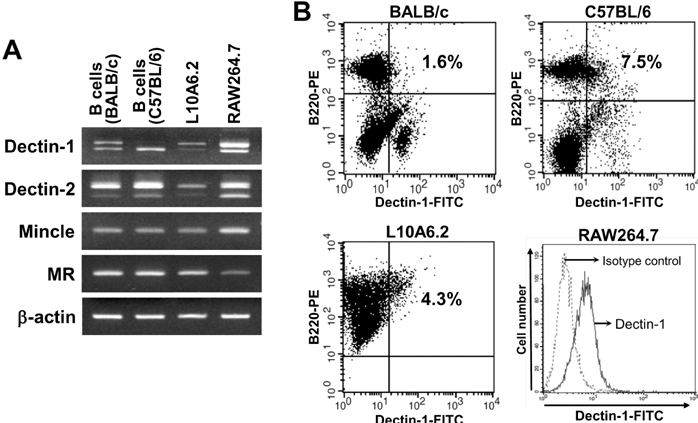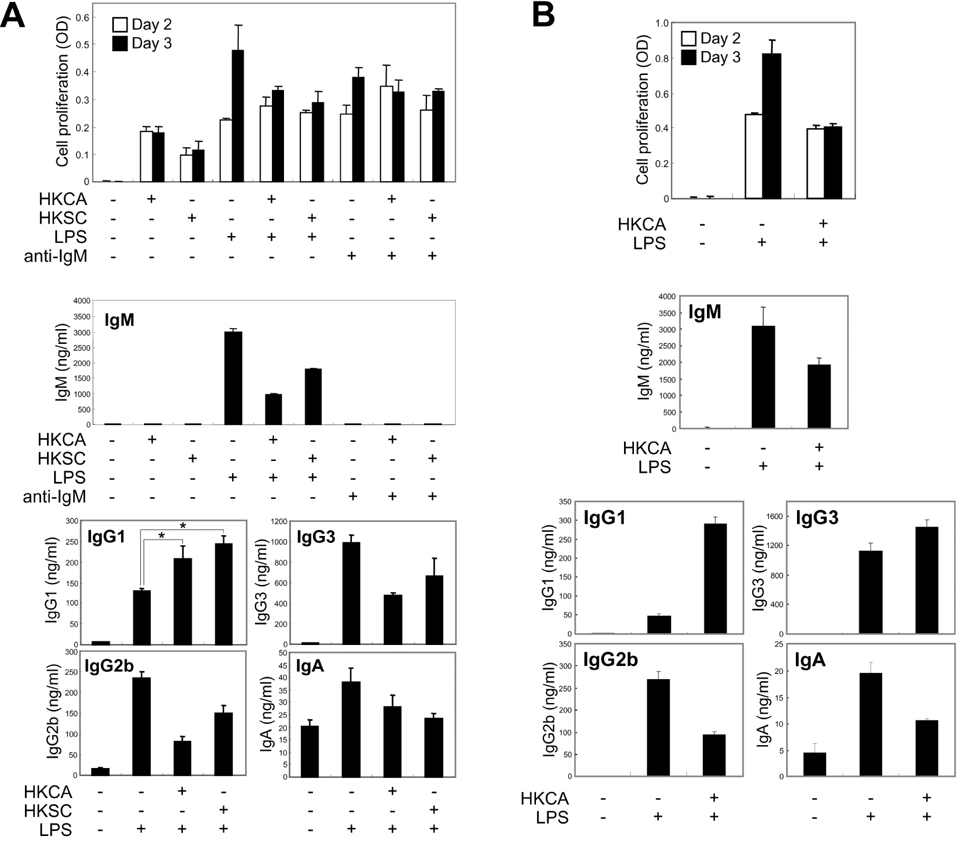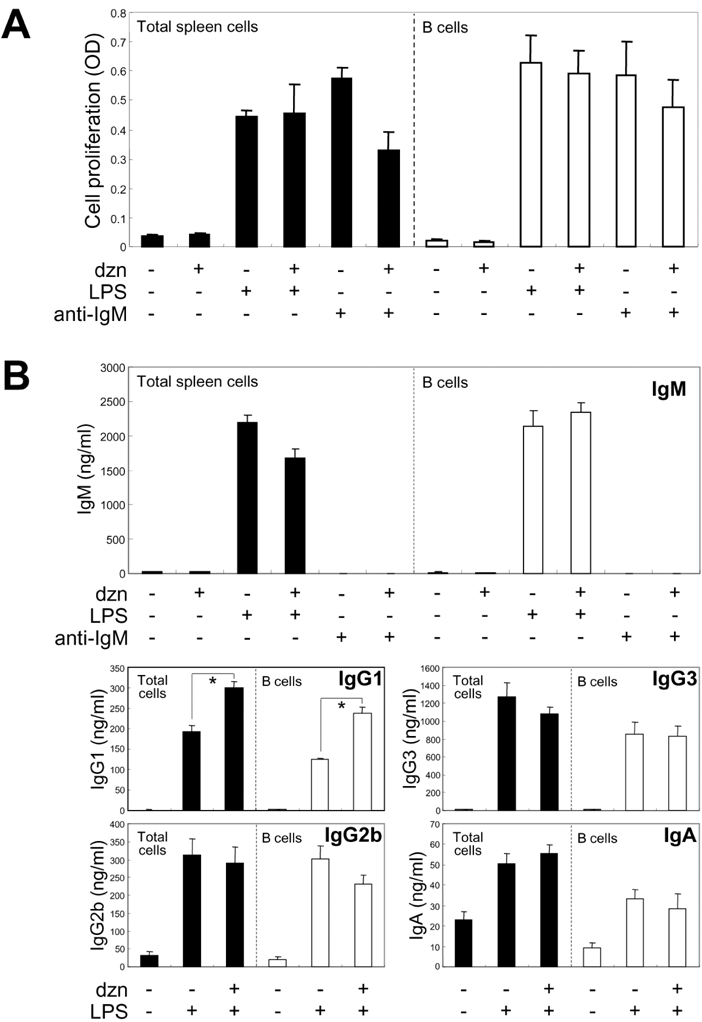Immune Netw.
2013 Oct;13(5):205-212. 10.4110/in.2013.13.5.205.
Dectin-1 Stimulation Selectively Reinforces LPS-driven IgG1 Production by Mouse B Cells
- Affiliations
-
- 1Department of Microbiology, Myunggok Medical Research Institute, College of Medicine, Konyang University, Daejeon 302-718, Korea. srpark@konyang.ac.kr
- KMID: 1493615
- DOI: http://doi.org/10.4110/in.2013.13.5.205
Abstract
- Dectin-1, which specifically recognizes beta-glucan of fungal cell walls, is a non-Toll-like receptor (TLR) pattern recognition receptor and a representative of C-type lectin receptors (CLRs). The importance of Dectin-1 in innate immune cells, such as dendritic cells and macrophages, has previously been well studied. However, the function of Dectin-1 in B cells is very poorly understood. To determine the role of Dectin-1 in B cell activation, we first investigated whether mouse B cells express Dectin-1 and then assessed the effect of Dectin-1 stimulation on B cell proliferation and antibody production. Mouse B cells express mRNAs encoding CLRs, including Dectin-1, and surface Dectin-1 was expressed in B cells of C57BL/6 rather than BALB/c strain. Dectin-1 agonists, heat-killed Candida albicans (HKCA) and heat-killed Saccharomyces cerevisiae (HKSC), alone induced B cell proliferation but not antibody production. Interestingly, HKSC, HKCA, and depleted zymosan (a selective Dectin-1 agonist) selectively enhanced LPS-driven IgG1 production. Taken together, these results suggest that, during fungal infection, beta-glucan-stimulated Dectin-1 may cooperate with TLR4 to specifically enhance IgG1 production by mouse B cells.
Keyword
MeSH Terms
Figure
Cited by 1 articles
-
Heat-Killed Saccharomyces cerevisiae, A Dectin-1 Agonist, Selectively Induces IgG4 Production by Human B Cells
Ha-Yan Park, Hee-Kyung Yoon, Jong-Yeup Kim, Seok-Rae Park
Immune Netw. 2018;18(6):. doi: 10.4110/in.2018.18.e46.
Reference
-
1. Takeuchi O, Akira S. Pattern recognition receptors and inflammation. Cell. 2010; 140:805–820.
Article2. Michallet MC, Rota G, Maslowski K, Guarda G. Innate receptors for adaptive immunity. Curr Opin Microbiol. 2013; 16:296–302.
Article3. Willment JA, Brown GD. C-type lectin receptors in antifungal immunity. Trends Microbiol. 2008; 16:27–32.
Article4. Brown GD. Innate antifungal immunity: the key role of phagocytes. Annu Rev Immunol. 2011; 29:1–21.
Article5. Hardison SE, Brown GD. C-type lectin receptors orchestrate antifungal immunity. Nat Immunol. 2012; 13:817–822.
Article6. Wuthrich M, Deepe GS Jr, Klein B. Adaptive immunity to fungi. Annu Rev Immunol. 2012; 30:115–148.
Article7. Romani L. Immunity to fungal infections. Nat Rev Immunol. 2011; 11:275–288.
Article8. Brown GD. Dectin-1: a signalling non-TLR pattern-recognition receptor. Nat Rev Immunol. 2006; 6:33–43.
Article9. Drummond RA, Brown GD. The role of Dectin-1 in the host defence against fungal infections. Curr Opin Microbiol. 2011; 14:392–399.
Article10. Taylor PR, Tsoni SV, Willment JA, Dennehy KM, Rosas M, Findon H, Haynes K, Steele C, Botto M, Gordon S, Brown GD. Dectin-1 is required for beta-glucan recognition and control of fungal infection. Nat Immunol. 2007; 8:31–38.
Article11. Kimberg M, Brown GD. Dectin-1 and its role in antifungal immunity. Med Mycol. 2008; 46:631–636.
Article12. Taborda CP, Casadevall A. CR3 (CD11b/CD18) and CR4 (CD11c/CD18) are involved in complement-independent antibody-mediated phagocytosis of Cryptococcus neoformans. Immunity. 2002; 16:791–802.
Article13. Torosantucci A, Bromuro C, Chiani P, De Bernardis F, Berti F, Galli C, Norelli F, Bellucci C, Polonelli L, Costantino P, Rappuoli R, Cassone A. A novel glyco-conjugate vaccine against fungal pathogens. J Exp Med. 2005; 202:597–606.
Article14. Casadevall A, Pirofski LA. A reappraisal of humoral immunity based on mechanisms of antibody-mediated protection against intracellular pathogens. Adv Immunol. 2006; 91:1–44.
Article15. McClelland EE, Nicola AM, Prados-Rosales R, Casadevall A. Ab binding alters gene expression in Cryptococcus neoformans and directly modulates fungal metabolism. J Clin Invest. 2010; 120:1355–1361.
Article16. Casadevall A, Pirofski LA. Immunoglobulins in defense, pathogenesis, and therapy of fungal diseases. Cell Host Microbe. 2012; 11:447–456.
Article17. Park SR, Kim PH, Lee KS, Lee SH, Seo GY, Yoo YC, Lee J, Casali P. APRIL stimulates NF-kappaB-mediated HoxC4 induction for AID expression in mouse B cells. Cytokine. 2013; 61:608–613.
Article18. Yang Z, Marshall JS. Zymosan treatment of mouse mast cells enhances dectin-1 expression and induces dectin-1-dependent reactive oxygen species (ROS) generation. Immunobiology. 2009; 214:321–330.
Article19. Ariizumi K, Shen GL, Shikano S, Ritter R 3rd, Zukas P, Edelbaum D, Morita A, Takashima A. Cloning of a second dendritic cell-associated C-type lectin (dectin-2) and its alternatively spliced isoforms. J Biol Chem. 2000; 275:11957–11963.
Article20. Kim YH, Lee SH, Yoo YC, Lee J, Park JH, Park SR. Kinetic analysis of CpG-Induced mouse B cell growth and Ig production. Immune Netw. 2012; 12:89–95.
Article21. Willment JA, Marshall AS, Reid DM, Williams DL, Wong SY, Gordon S, Brown GD. The human beta-glucan receptor is widely expressed and functionally equivalent to murine Dectin-1 on primary cells. Eur J Immunol. 2005; 35:1539–1547.
Article22. Taylor PR, Brown GD, Reid DM, Willment JA, Martinez-Pomares L, Gordon S, Wong SY. The beta-glucan receptor, dectin-1, is predominantly expressed on the surface of cells of the monocyte/macrophage and neutrophil lineages. J Immunol. 2002; 169:3876–3882.
Article23. Kumar H, Kumagai Y, Tsuchida T, Koenig PA, Satoh T, Guo Z, Jang MH, Saitoh T, Akira S, Kawai T. Involvement of the NLRP3 inflammasome in innate and humoral adaptive immune responses to fungal beta-glucan. J Immunol. 2009; 183:8061–8067.
Article24. Gantner BN, Simmons RM, Canavera SJ, Akira S, Underhill DM. Collaborative induction of inflammatory responses by dectin-1 and Toll-like receptor 2. J Exp Med. 2003; 197:1107–1117.
Article25. Mukhopadhyay S, Herre J, Brown GD, Gordon S. The potential for Toll-like receptors to collaborate with other innate immune receptors. Immunology. 2004; 112:521–530.
Article26. Dennehy KM, Ferwerda G, Faro-Trindade I, Pyz E, Willment JA, Taylor PR, Kerrigan A, Tsoni SV, Gordon S, Meyer-Wentrup F, Adema GJ, Kullberg BJ, Schweighoffer E, Tybulewicz V, Mora-Montes HM, Gow NA, Williams DL, Netea MG, Brown GD. Syk kinase is required for collaborative cytokine production induced through Dectin-1 and Toll-like receptors. Eur J Immunol. 2008; 38:500–506.
Article27. Dennehy KM, Willment JA, Williams DL, Brown GD. Reciprocal regulation of IL-23 and IL-12 following co-activation of Dectin-1 and TLR signaling pathways. Eur J Immunol. 2009; 39:1379–1386.
Article28. Kawai T, Akira S. Toll-like receptors and their crosstalk with other innate receptors in infection and immunity. Immunity. 2011; 34:637–650.
Article29. LeibundGut-Landmann S, Gross O, Robinson MJ, Osorio F, Slack EC, Tsoni SV, Schweighoffer E, Tybulewicz V, Brown GD, Ruland J, Reis e Sousa C. Syk- and CARD9-dependent coupling of innate immunity to the induction of T helper cells that produce interleukin 17. Nat Immunol. 2007; 8:630–638.
Article30. Ferwerda G, Meyer-Wentrup F, Kullberg BJ, Netea MG, Adema GJ. Dectin-1 synergizes with TLR2 and TLR4 for cytokine production in human primary monocytes and macrophages. Cell Microbiol. 2008; 10:2058–2066.
Article31. Ni L, Gayet I, Zurawski S, Duluc D, Flamar AL, Li XH, O'Bar A, Clayton S, Palucka AK, Zurawski G, Banchereau J, Oh S. Concomitant activation and antigen uptake via human dectin-1 results in potent antigen-specific CD8+ T cell responses. J Immunol. 2010; 185:3504–3513.
Article32. Ikeda Y, Adachi Y, Ishii T, Miura N, Tamura H, Ohno N. Dissociation of Toll-like receptor 2-mediated innate immune response to Zymosan by organic solvent-treatment without loss of Dectin-1 reactivity. Biol Pharm Bull. 2008; 31:13–18.
Article33. Cassone A. Fungal vaccines: real progress from real challenges. Lancet Infect Dis. 2008; 8:114–124.
Article
- Full Text Links
- Actions
-
Cited
- CITED
-
- Close
- Share
- Similar articles
-
- Heat-Killed Saccharomyces cerevisiae, A Dectin-1 Agonist, Selectively Induces IgG4 Production by Human B Cells
- Toll-like Receptor 1/2 Agonist Pam3CSK4 Suppresses Lipopolysaccharide-driven IgG1 Production while Enhancing IgG2a Production by B Cells
- Co-stimulation of TLR4 and Dectin-1 Induces the Production of Inflammatory Cytokines but not TGF-beta for Th17 Cell Differentiation
- Expression of Microbial Receptors and Production of Cytokine in Mouse Keratinocyte Cells in Response to Lipopolysaccharide Stimulation
- Alum Directly Modulates Murine B Lymphocytes to Produce IgG1 Isotype




